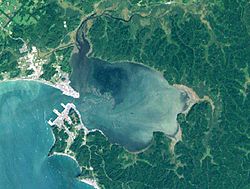
Lake Biwa is the largest freshwater lake in Japan, located entirely within Shiga Prefecture, northeast of the former capital city of Kyoto. Lake Biwa is an ancient lake, over 4 million years old. It is estimated to be the 13th oldest lake in the world. Because of its proximity to the ancient capital, references to Lake Biwa appear frequently in Japanese literature, particularly in poetry and in historical accounts of battles.
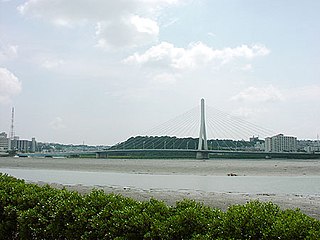
Lake Man is an area of wetlands in Okinawa that is located between the cities of Naha and Tomigusuku, and within Manko Park. Despite being called "Lake Man", it is in fact a wetland and not a lake. Lake Man covers .11 square kilometres (0.042 sq mi).

Kiritappu Wetland is a 3,168ha. wetland area in Hamanaka-cho, Akkeshi District, Hokkaidō, Japan. It is also called Wetland of flowers (花の湿原) because numerous flowers can be seen in summer.
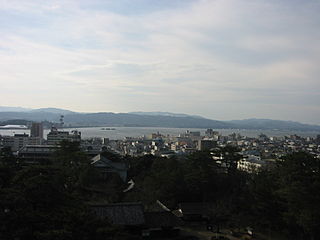
Lake Shinji is a lake in the northeast area of the Shimane Prefecture in Japan. The lake is the seventh largest in Japan, with a circumference of 48 kilometres (30 mi). It is enclosed by the Shimane Peninsula to the north, and the Izumo and Matsue plains to the west and east respectively. 7,652 ha of wetland are a Ramsar Site.
The Creston Valley Wildlife Management Area is a Canadian river delta wetland and Wildlife Management Area near Creston in south-central British Columbia, on the floodplain of the Kootenay River at the south end of Kootenay Lake. Predominantly marshland, it was classified as a wetland of international importance on February 21, 1994, and is also a globally significant Important Bird Area. It is one of the "few significant agricultural areas of the province", and is in the Montane Cordillera. It stretches north along Kootenay Lake for approximately 20 km, and south to the United States border. It is both the only breeding site of the Forster's tern and the only site with leopard frogs in the province, as well as one of the few Canadian habitats for the Coeur D'Alene salamander. Creston Valley provides staging and nesting areas for migratory birds on the Pacific Flyway.

Lake Warden is a salt lake in the Goldfields-Esperance region of Western Australia. It and its associated wetlands are protected in a nature reserve; they were recognised as being of international importance under the Ramsar Convention through designation of the Lake Warden System on 7 June 1990 as Ramsar Site 485. The lake is also a DIWA-listed wetland.

Lake Akan is a lake in Kushiro, Hokkaidō, Japan. It is located in Akan National Park and is a Ramsar Site.

Lake Ogawara is Japan's eleventh largest lake and the largest in Aomori Prefecture. It spans the boundaries of the city of Misawa, the town of Tōhoku, and the village of Rokkasho in Kamikita District.
The Port Phillip Bay and Bellarine Peninsula Ramsar Site is one of the Australian sites listed under the Ramsar Convention as a wetland of international importance. It was designated on 15 December 1982, and is listed as Ramsar Site No.266. Much of the site is also part of either the Swan Bay and Port Phillip Bay Islands Important Bird Area or the Werribee and Avalon Important Bird Area, identified as such by BirdLife International because of their importance for wetland and waterbirds as well as for orange-bellied parrots. It comprises some six disjunct, largely coastal, areas of land, totalling 229 km2, along the western shore of Port Phillip and on the Bellarine Peninsula, in the state of Victoria. Wetland types protected include shallow marine waters, estuaries, freshwater lakes, seasonal swamps, intertidal mudflats and seagrass beds.
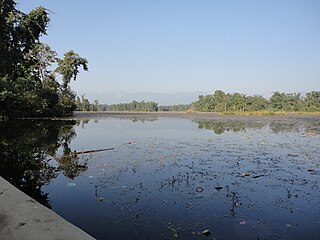
Ghodaghodi Tal is a Ramsar site in western Nepal. Established in August 2003 it covers an area of 2,563 ha in Kailali District at an altitude of 205 m (673 ft) on the lower slopes of the Siwalik Hills. This Ramsar site consists of a system of around 13 large and shallow oxbow lakes and ponds with associated marshes and meadows. It is surrounded by tropical deciduous forest and some streams along the periphery, which are separated by hillocks.

Bishazari Tal, also spelled Beeshazar Tal, is an extensive oxbow lake system in the buffer zone of the Chitwan National Park, a protected area in the Inner Terai of central Nepal. This wetland covers an area of 3,200 ha at an altitude of 286 m (938 ft), and is situated between the Mahabharat mountain range to the north and the Siwalik range to the south. In August 2003, it has been designated as a Ramsar site.

Fujimae-higata (藤前干潟) is a tidal flat beside the Port of Nagoya in Aichi Prefecture, Japan. A campaign to stop further development has made Fujimae a symbol of the wetland conservation movement in Japan. Once celebrated in the Man'yōshū, the remaining 323 ha of wetlands have been designated a Ramsar Site.
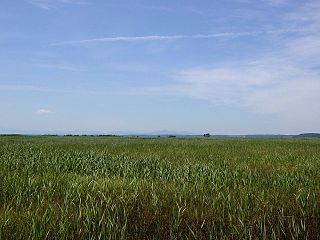
Hotokenuma (仏沼) is a wetland area located in the northern part of the city of Misawa, Aomori Prefecture, in the northern Tōhoku region of Japan. The wetland is connected to the eastern shores of Lake Ogawara at the base of the Shimokita Peninsula.
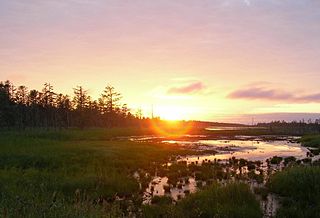
Fūren-ko (風蓮湖) is a brackish lake near Nemuro in Hokkaidō, Japan. The wetlands of Lake Furen and the shunkuni-tai (春国岱) dunes have been designated a Ramsar Site.

Sarobetsu-genya (サロベツ原野), derived from the Ainu sar (marsh) and pet (river), is a coastal plain and low-lying moor in northwestern Hokkaidō, Japan. With an area of approximately 20,000 ha or 200 km2 (77 sq mi), it forms part of the Rishiri-Rebun-Sarobetsu National Park, and its wetlands are a Ramsar Site.

Biwako Kokutei Kōen (琵琶湖国定公園) is a Quasi-National Park in Shiga Prefecture and Kyoto Prefecture, Japan. It was founded on 24 July 1950 and has an area of 976.7 km2 (377 sq mi). In June 1993 an area of 65,984 ha beside Lake Biwa was designated a Ramsar Site and wetland of international importance.

Akkeshi Prefectural Natural Park is a Prefectural Natural Park in eastern Hokkaidō, Japan. Established in 1955, the park spans the municipalities of Akkeshi, Hamanaka, and Kushiro. It comprises two non-contiguous stretches of the coast, adjoining areas of lake, marsh, wetland, and forest, and several islands.

Lake Tōfutsu is located in Abashiri and Koshimizu, Hokkaidō, Japan. It takes its name from the Ainu toputsu, or 'mouth of the lake'. A saline lagoon divided from the Sea of Okhotsk by sand dunes, Lake Tōfutsu provides an important habitat for wintering birds. In 2005 an area of 900 ha of wetlands was designated a Ramsar Site.

Laidevahe Nature Reserve is a nature reserve situated on Saaremaa in western Estonia, in Saare County.
